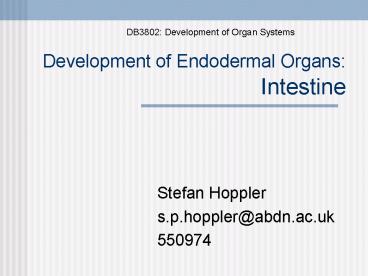Development of Endodermal Organs: Intestine - PowerPoint PPT Presentation
1 / 27
Title:
Development of Endodermal Organs: Intestine
Description:
Differential transcription factor gene expression in a Chick endoderm. ... caudal. pdx. gsx. cdx. pdx. gsx. A-P patterning of endoderm. patterning of mesoderm ... – PowerPoint PPT presentation
Number of Views:566
Avg rating:3.0/5.0
Title: Development of Endodermal Organs: Intestine
1
Development of Endodermal Organs Intestine
DB3802 Development of Organ Systems
- Stefan Hoppler
- s.p.hoppler_at_abdn.ac.uk
- 550974
2
Embryonic origin of Endoderm
Xenopus
3
Embryonic origin of Endoderm
Amniote embryo Chick
4
Embryonic origin of endoderm
- Major derivatives of ectoderm
- Pharynx
- Esophagus
- Stomach
- Intestine
- Lung
- Liver
- Pancreas
Amniote embryo Chick
5
Determination of Endoderm
Veg T
nodal signalling
Gata4
Sox17?
Gata5
mixer
Mix1
Sox17?
Gata6
Endoderm
6
The concept of Mesendoderm
Traditional Model (text book)
Alternative Model
nodal
Gata456
mesendoderm
endoderm
mesoderm
ectoderm
ectoderm
neural skin etc.
Gut, lung epithelium etc.
Bone, Muscle, Blood etc.
Nkx2.5
HNF
endoderm
mesoderm
N/C
neural
epidermis
Bone Muscle
supported by molecular biology from Xenopus,
zebrafish and C. elegans
supported by classic embryology
Evolution diploblastic to triploblastic bilateria
7
Regionalisation of the endoderm
Differential transcription factor gene expression
in a Chick endoderm.
anterior
posterior
- Essentially one-dimentional patterning
- Expression of Hox-cluster genes.
- Expression of ParaHox cluster genes.
8
The ProtoHox Hypothesis
Peter Holland Jordi Garcia-Fernàndez David Ferrier
5
3
Protohox Cluster
anterior
posterior
duplications during triploblast bilaterian
evolution
caudal
pdx
gsx
6x
5x
2x
Ancestral Hox cluster A-P patterning of the
ectoderm
Ancestral NK cluster A-P patterning of the
mesdoderm
Ancestral ParaHox cluster A-P patterning of the
endoderm
Nkx2-3
Nkx2-5
cdx
pdx
gsx
A-P patterning of endoderm
patterning of mesoderm
A-P patterning of all germ layers
9
Epithelial-Mesenchymal interactions
Shh signals from the endoderm to the mesoderm
10
Coordinated A-P patterning of splanchnic mesoderm
and endoderm
Nkx2.3
?
shh
11
Tissue recombination experiments
Mesoderm generally provides permissive signals
rather than instructive induction.
Posterior Dominance anterior endoderm can be
reprogrammed by posterior mesoderm, but posterior
endoderm cannot be reprogrammed
12
Endoderm derivatives other than gut and intestine
Liver Pancreas Lung
To be discussed in more detail in the next lecure
by Dr Martin Collinson
13
Cell differentiation in the intestine
14
Cell differentiation in the intestine
small intestine
15
Differentiated cells of the small intestine
16
Differentiated cells of the small intestine
- Structure and Function of the small intestine
- Structure
- Villus Enterocytes, Goblet cells,
enteroendocrine cells - Crypt Paneth cells (and the stem cells)
- Function
- Absorptive cells Enterocytes absorption from
the gut lumen and transporting of nutrients
across the epithelium - Secretory cells
- Enteroendocrine cells coordinate gut function
(hormones) - Goblet cells physical and chemical protection
(mucus) - Paneth cells antibacterial defence (bactericidal
defensin and lysozymes)
17
Mutations in the Wnt signalling pathway cause
colorectal cancer
80 of colorectal cancer is caused by APC
mutations
APC adenomatous polyposis coli
18
Mutations in the Wnt signalling pathway cause
colorectal cancer
Mutations in the Wnt signalling component APC
(and less frequently in ?-catenin or Axin) cause
human colorectal cancer.
Normal Wnt signalling regulates proliferation (in
the crypt) versus differentiation (outside the
crypt).
19
Cell differentiation in the intestine
Structure and Function of the large intestine
similar to those of the small intestine. Differen
ces Large intestine has no villi and no Paneth
cells
20
Mouse Model of CRC
APC mutations in mouse cause cancer, but in the
small intestine
21
Wnt signalling regulates intestinal cell
differentiation
Wnt signalling controls cell proliferation in the
crypt.
22
The hunt for the intestinal stem cell
Two competing models
Stem cells are located between the terminally
differentiated Paneth cells and the transient
amplifying cells (i.e. in position 4)
Stem cells are identical with the crypt base
columnar (CBC) cells, which are intermingled with
the terminally differentiated Paneth cells.
Definitive proof for either model has proven
elusive due to lack of a specific marker for
these suspected stem cells.
23
Wnt signalling regulates intestinal cell
differentiation
Wnt signalling controls cell proliferation in the
crypt.
24
Microarray analysis to identify Wnt target genes
in the intestine
normal
dnTcf4
green down regulated
yellow same expression
red up regulated
Analysing the RNA expression of thousands of genes
Green potential Wnt target genes in the
intestine In situ hybridization confirmed that
some to these genes are expressed in adenomas and
proliferative normal crypts.
25
Lgr5 is an intestinal stem cell marker
Lgr5 is a marker for the CBC cells, which are the
stem cells of the intestine.
1 day
6 months
Lgr5 encodes an orphan GPCR with a large
leucine-rich extracellular domain.
Labelled CBC cells give rise to all the
differentiated cells in the intestine.
Lgr5 is expressed in the CBC cells
26
Notch signalling regulates intestinal cell
differentiation
Lateral inhibition, mediated by Notch signalling,
regulates secretory versus absorptive lineage
cell differentiation
27
Cell differentiation in the intestine
- Wnt and Notch signalling regulate stem cell
differentiation in the the intestine - Wnt mainly regulates the maintenance of the stem
cells and proliferation of the transient
amplifying cells. - Notch signalling mainly regulates cell
differentiation between the secretory and the
absorptive lineages.

